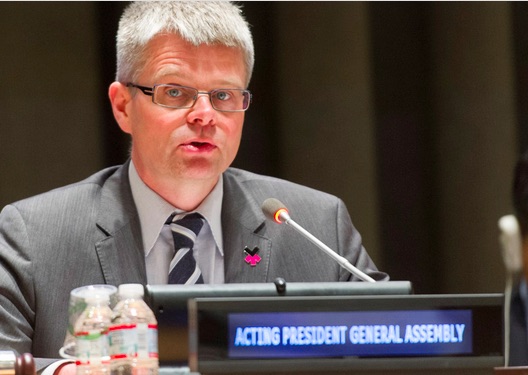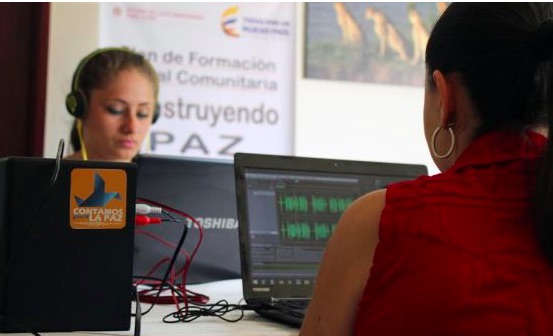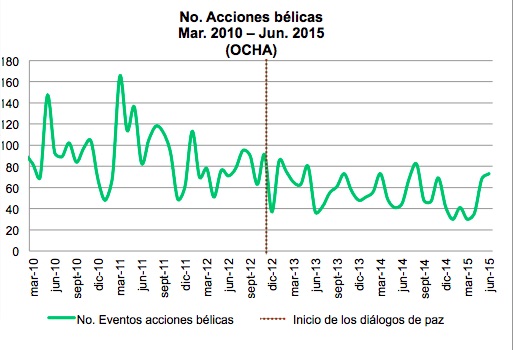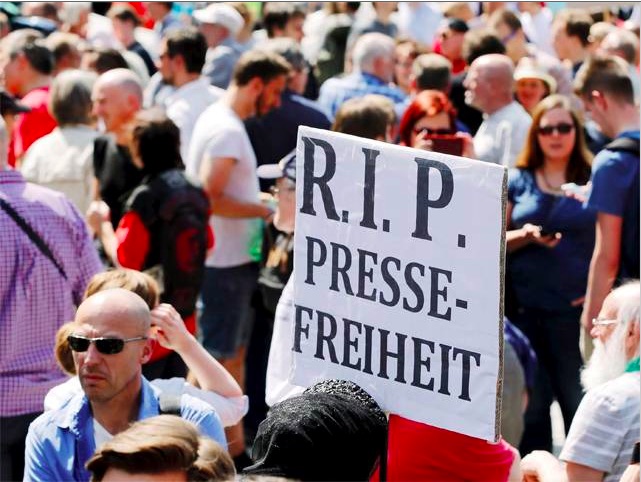FREE FLOW OF INFORMATION
An article from The UN News Centre
United Nations officials today [9 September] shared a common message that building a culture of peace means not just ending conflict but building inclusive societies that are able to develop and thrive in the absence of discrimination.

Ambassador Einar Gunnarsson of Iceland. UN Photo/Mark Garten
“Today’s discussion is an opportunity to focus on what we need to do on our pathway to a new and prosperous future for all,” said Ambassador Einar Gunnarsson of Iceland, speaking on behalf of the President of the General Assembly, at the High-level Forum on a Culture of Peace.
“Experience has shown us that peace is not simply the absence of conflict,” he stated. “Peace requires equitable societies, inclusive education and tangible actions on the ground.
“More importantly, peace is a distant dream without development. This is part of the core challenge in promoting a culture of peace and ensuring peaceful societies.”
Mr. Gunnarsson also spoke of the need to create a national community to promote dialogue, enhance respect for religious and cultural diversity, and eliminate all forms of discrimination and intolerance, while developing policies to promote peace, security, the rule of law and democratic decision-making.
Today’s event was designed to highlight the importance of implementation of the Declaration and Programme of Action on a Culture of Peace that the Assembly adopted in September 1999 and the need to further strengthen global movements to promote a culture of peace.
Secretary-General Ban Ki-moon shared his thoughts on how to bring about a culture of peace, highlighting humanitarian crises around the world and violations of international human rights laws.
“Today’s meeting is about the very hard truths in our world,” he said, “where people are suffering and dying from violence and atrocity crimes.”
“Syria is the world’s worst humanitarian crisis today,” he said. “I have condemned the parties – especially the Government – for reported grave violations of human rights and international humanitarian law that may amount to war crimes and crimes against humanity.”
As well as speaking about war-torn regions, Mr. Ban noted: “Even in mostly peaceful, democratic societies, minorities are attacked for their race, sexual orientation or some other difference – when they should be embraced for our common humanity.”
He also paid tribute to those countries, communities and people who had shown compassion, rather than xenophobia and discrimination.
“We cannot build a culture of peace without an active campaign against division and injustice,” said Mr. Ban. “To be more than just soothing words, the culture of peace demands courageous practice.”
Arun Gandhi, a grandson of the late Mahatma Gandhi, delivered the keynote address at the meeting, and shared some of the knowledge he said he had gathered from one of the great leaders of the Indian independence movement.
“What I learned from grandfather is that each one of us contributes to violence all the time. Many times in ways we don’t even know and recognize,” he said. “Unless we individually transform ourselves and accept a non-violent way of life, we cannot create peace in the world today.”
He said that, in the words of his grandfather, “we must become the change we wish to see in the world,” adding that “unless we change ourselves and our attitudes, we are not going to be able to change the world at all.”
for the world we want.
Can the UN help move the world toward a culture of peace?
The following comes from the CPNN Coordinator’s blog of October 2012
The United Nations and the Culture of Peace
My ten years working in the United Nations system left me with a sweet and sour taste: the sweet side was the universality of the UN, both its staff and mandate, and its great significance for raising the consciousness of the peoples of the world; the sour side was the jealousy of the Member States who make sure that the UN does not encroach on their freedom to rule over their own citizens, as well as people in other countries that they may dominate through neo-colonial relations. This became crystal-clear to me when the United States delegate, during the informal meetings of the UN General Assembly in 1999, opposed the Declaration and Programme of Action on a Culture of Peace, saying that it would make it more difficult for them to start a war. In fact, throughout history, war (call it “defense” if you prefer) has always been the most fundamental “right” of the state
With this in mind, I have been pleasantly surprised by the extent to which the UN system has once again taken up the culture of peace as a priority, as shown in this month’s CPNN bulletin, just as it was a priority in the Year 2000 when I was the director of the UN International Year for the Culture of Peace
Of course, this does not happen by chance, and great credit belongs to two men who played key roles for the Year 2000, Federico Mayor Zaragoza, who made the culture of peace a priority of UNESCO, and Anwarul Chowdhury, who played the role of midwife at the UN General Assembly, guiding the culture of peace resolution through nine months of opposition by the powerful states. Once again, this last month, these two men motivated and spoke eloquently at the High Level Forum on a Culture of Peace at the UN
As always it was the countries of the South who supported the initiative (see the CPNN article of September 24 and its discussion), but at least this month it was not blocked by the powerful states
In fact, it is my impression that the powerful states pay less and less attention to the United Nations. When there was a financial crisis a few years ago, the powerful states did not turn to the UN agencies , the World Bank and the International Monetary Fund, but set up their own temporary system of finance ministers, and when it came time for the review of nuclear non-proliferation, President Obama held his own meeting with heads of state in Washington and ignored the UN conference where the only head of state to speak was that of Iran. And the US has pulled out of UNESCO entirely, forcing drastic cuts in its budget
In fact, the lack of attention by the powerful states may provide the UN system with an opportunity to push the agenda of the culture of peace without their opposition – let us hope that the UN can take advantage of this
Of course, in the long run, the UN, or any other institution, cannot mandate a culture of peace; instead, the culture of peace can only grow from the consciousness, both understanding and action, of the peoples of the world (see last month’s blog below). That’s why the role of the UN for consciousnes-raising is ultimately its greatest contribution!








